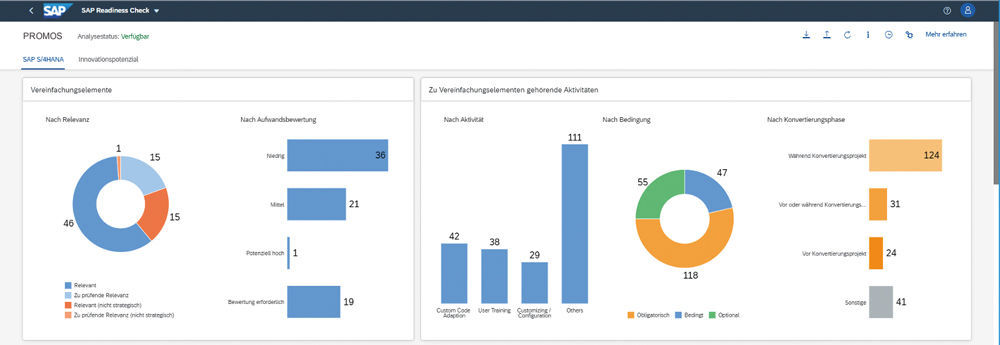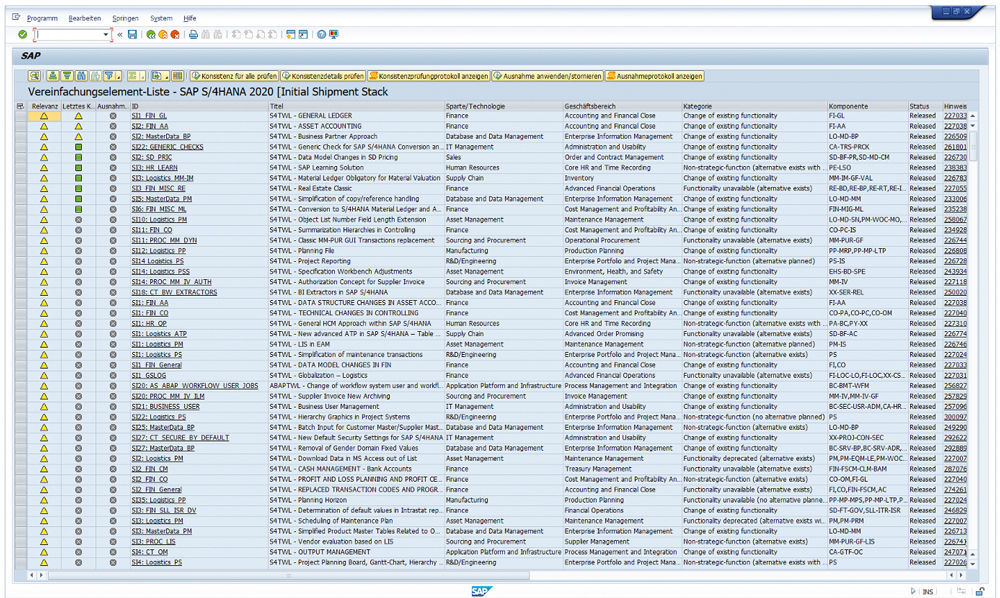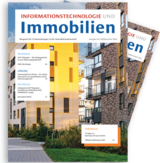SAP S/4HANA® migration – A thorough preparation phase as the key to success
The two phases of S/4HANA® migration
For users of SAP® ECC 6.0 systems, the switch to S/4HANA® is just as inevitable as buying a new car. In addition to the fact that maintenance will be discontinued in the foreseeable future, S/4HANA® with Fiori® also offers significant improvements in application handling. Many people are reluctant to undertake the complex migration, though. How extensive is the transition, and will the system still work just as smoothly in S/4HANA®? These are questions that companies like to put off answering. However, this is not the right move here. Good preparation can provide information on the scope of migration work and accurately determine which areas require adjustments to ensure compatibility – and all this before the actual migration project. We therefore distinguish between a preparation phase and an implementation phase. The preparation can be completely separate from the actual conversion at a later date. Good preparation consists not only of a simple analysis of the actual situation, but also the adaptation of data structures and workflows, which can already be carried out in the running ECC 6.0 system. This approach can significantly reduce migration work and system interruptions. This is made possible by special tools as well as continuous and systematic support from SAP® consulting experts.

Figure 1: A good, intensive preparation phase is an important basis for a smooth migration. SAP is gradually expanding its tools for this purpose.
 Figure 1: A good, intensive preparation phase is an important basis for a smooth migration. SAP is gradually expanding its tools for this purpose. |
SAP Readiness Check – Overview, need for action, potential
The first important step in the pre-analysis is the SAP Readiness Check, an external application from SAP that is launched via web browser. It is fed extract files of the usage and configuration data obtained using a recording from the customer’s productive system. The Readiness Check then provides various key figures and analyses indicating the system’s compatibility and necessary preparatory steps. A clear dashboard visualises the results. And what concrete information does the SAP Readiness Check provide? Customers first get an overview of which functions are actually used in their companies and to what extent they are compatible with S/4HANA®. The consultant and the customer can then jump to the corresponding detail view together and assess whether there is a real need for adjustments. For example, if the material number field in S/4HANA® is shortened but the customer does not use long material numbers, this change is irrelevant for them. This assessment is included in the SAP Readiness Check evaluation. The Readiness Check also provides information on which add-ons are currently installed in the system. There might be an OCR software for the invoice receipt workflow, for instance. The tool independently analyses the software’s compatibility with S/4HANA®. An important part of the check is a comparison with the simplification elements for S/4HANA®. There have been a number of simplifications and changes compared to SAP® ECC 6.0 and more are in continuous development. Such changes require an adaptation of the existing data structures.
There is also an interesting overview of useful SAP Fiori® apps for the customer. Based on previous usage behaviour, the Readiness Check recommends exactly the Fiori® applications that will be most helpful and useful. The functional scope also includes an assessment of which business processes may have potential for improvement. This preliminary analysis can be used to give the customer an appraisal of the necessary licences and the sizing for the required system hardware. In addition, preliminary considerations can be made with the customer about whether a Greenfield or Brownfield migration is more suitable. Overall, the SAP Readiness Check provides the customer with a cross-section view of the benefits of the migration and how comprehensive it will be. The SAP Readiness Check is generally performed several times. This makes sense, since new simplification elements are delivered with each new S/4HANA® release and adaptations can be necessary. The existing old system is also subject to continuous changes in its use and characteristics.

Figure 2: A clear dashboard provides information about necessary adjustments in the browser-based SAP Readiness Check.

Figure 3: The Simplification Item Check delivers insight on the relevance of the simplification elements from S/4HANA® for the conversion in the specific SAP® ECC 6.0 customer system.
Simplification Item Check – Determine areas requiring action directly in the system
After the preliminary analysis with the external SAP Readiness Check, a detailed analysis is then carried out in the SAP® customer system. An important tool in this context is the Simplification Item Check (SI Check), which checks the simplification elements for S/4HANA® for compatibility with the existing system, as in the Readiness Check. The SI Check is carried out directly in the productive system or client. The required notes are checked beforehand on the test system. The results list from the test run provides a detailed view of the extent to which the customer’s SAP® system is affected by the simplifications. The tool distinguishes between three cases here:
- The simplification is irrelevant because it does not affect any application/functionality used by the customer.
- The simplification is relevant, but does not require any further attention as it does not cause any compatibility problem (e.g. a change in length of material numbers if the customer does not use long material numbers).
- The simplification is relevant and adjustments are required (e.g. if the customer needs to switch from managing creditors and debtors to business partner management).
The required actions identified here can often already be implemented in the running SAP® system, such as the conversion to the business partner approach. Such preparatory activities can be carried out entirely separately before the actual migration, which is thus considerably streamlined with minimal system interruptions.
Menu-driven tools for preparation work directly in the system
SAP has been supporting this approach more intensely for the past one to two years and is gradually expanding its range of relevant supporting tools. The Customer Vendor Integration Cockpit (CVI Cockpit), to name one, was created specifically for converting data structures to be compatible with business partner management. This menu-driven application provides a step-by-step process with click boxes to perform all activities necessary for consistent mapping of the business partner approach in SAP® – all in the running ECC 6.0 system. An evaluation program for the reconciliation of FI documents has existed for some time now, and a corresponding tool for the reconciliation of asset accounting was also recently added. In the future, we can expect a gradual expansion of such preparatory programs for the implementation work surrounding typically complex topics.
Custom Code Migration Check – Check individual programming for compatibility
A final important step in the preparation phase is checking customised programs. Each new S/4HANA® release brings programming changes, such as simplified table structures or standardised programming techniques. This may mean that customer-specific programs using certain components of the SAP system would no longer work after the migration because they have been changed. The ATC Custom Code Migration Check was created to assess this. It, too, is based on the approach of initially carrying out a continuous analysis of the productive system over some 15 months before the actual migration date in order to find out which customer-specific programs are in operation. It also identifies unused applications that can be deleted with the migration, such as outdated SAP® RE Classic programming. The tool then checks the compatibility of the respective applications. If necessary, the check can also be performed remotely via a more up-to-date SAP® system (e.g. for the Solution Manager) against the production system that has not yet been updated to the required release version of SAP NetWeaver®.
Summary
Overall, the past few years have seen SAP significantly step up its tools to support the preparatory measures for a migration. Why is it prudent to focus on systematic and careful preparation? When determining the actual adaptation needs and potential for improvement in the migration, a long-term analysis of the SAP® system is useful for obtaining an overview of the entire scope of use. In addition, much of the necessary migration work can be carried out in the running ECC 6.0 system – completely separate from the actual migration. This makes the subsequent conversion leaner and clearer. It’s not without reason that some say good preparation is half the battle!
Author:

Magnus Temme
Senior Expert
PROMOS consult
Other articles by this author:


